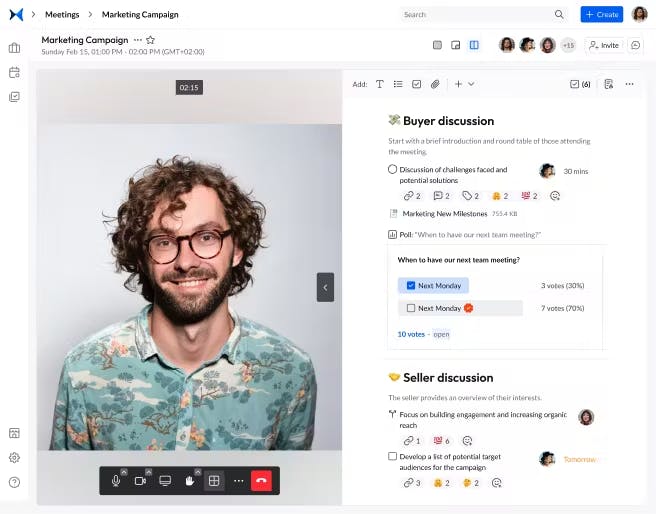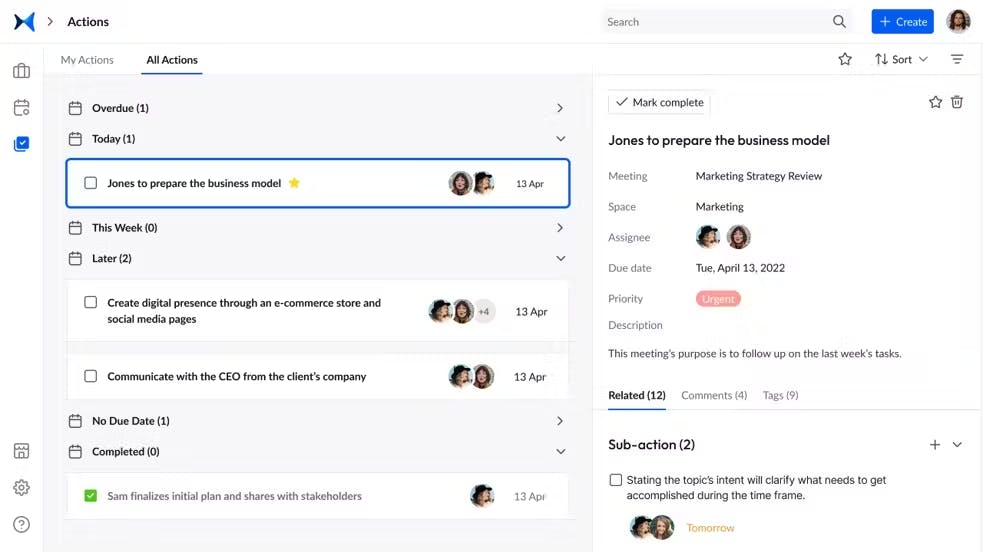June 19, 2022 · 14 min read
One on One Meeting: What It's All About (+Agenda Template)

Shaimaa Badawi

While you may feel that you already have a ton of meetings during the week, a one on one meeting is not one you want to leave out of your schedule.
One on one meetings are a great way for managers to touch base with each employee's strengths, weaknesses, goals, and achievements. It's a chance for employees to receive and give regular feedback, which reflects directly on their motivation and productivity.
In this article, we're going to discuss what one on one meetings are all about, so let's dive in.
What is a one on one meeting?
Also known as 1:1, check-in(s), one-to-one(s), a one on one meeting is conducted between a manager and an employee to discuss the goals, progress, obstacles, and any work-related topics specific to that employee.
It's a chance for managers to check up on their employees individually, provide feedback on their performance, resolve any issues, and create solid action plans for them to follow.
In other words, a one on one meeting is focused on the employee to lay the groundwork for an effective working relationship based on trust, support, and respect.
The only way to have transformational 1-on-1 meetings is by having an open channel of communication between the manager and employee to give the latter the space to voice their concerns and suggestions in ongoing or upcoming projects.
Let's dive into the main purpose of having one on one meetings and why maintaining transparency with each team member is crucial.
Why is scheduling regular one on one meetings important?
A one on one meeting is the ultimate way to get employees engaged in the workplace to ensure the success of a team or the organization as a whole.
Focusing on each employee individually and giving them the time to express themselves is the first building block of a successful business, so it's safe to say that the main purpose of one on one meetings is to increase employee engagement.
Why is employee engagement important? According to Gallup, "Engaged employees produce better business outcomes than other employees -- across industry, company size and nationality, and in good economic times and bad."
If employees aren't engaged, it makes it difficult for teams to be engaged and collaborate, which affects business outcomes.
Let's look into further details about the benefits of one on one meetings.
What are the benefits of one on one meetings?
A great manager understands the need for one on one meetings that help to build a trusting relationship, share insights and updates on a personal level, map out a specific roadmap for the employee to follow, and resolve any hurdles and obstacles the employee might be facing.
Here are the top benefits of conducting one on one meetings:
1. Create a better relationship dynamic
Meeting with your employees individually shapes a healthy relationship dynamic of mentor-mentee versus manager-employee. This dynamic creates an open channel of communication bunded with support, trust, and respect and prevents minor issues from festering into bigger problems.
The manager will discover what makes each employee motivated and which areas they're most interested in, which makes task assigning much easier and helps to uphold a proactive work environment.
It's also a great way to make every employee feel that they matter to the team and that their work is acknowledged and valued.
2. Foresee potential hurdles
A regular one on one meeting with each employee will help you generate insights that may catch potential problems before they happen.
Whether it's a personal problem with a colleague or a specific issue in the workflow, 1:1s are a great way to spot current problems and foresee potential ones. This way, you can discuss solutions with your employee, who will feel much more comfortable sharing their ideas with you in a private meeting.
3. Provide a safe space for feedback
Giving regular feedback to employees is one of the best ways to increase employee engagement at work and what better way to do that than one on one meetings.
A 1:1 is the perfect place to provide your insights on an employee's past performance by highlighting their strengths not calling out their weaknesses.
You won't have to send them the dreaded "We need to talk" message and reserve your comments for the next one on one meeting. By no means should you ever share your feedback in public unless it's a noteworthy achievement that should be celebrated among the team.
4. Enhance productivity
When you spend half an hour every couple of weeks with each employee, you'd be dedicating at least one hour a month to enhance their productivity and quality of work, which translates directly into the team's overall performance.
As a manager, you get to spend quality time with each individual and find out ways to bring the best out of them. For employees, it's a chance to learn whether or not they're doing a good job and how much their hard work matters to the business.
When employees feel they're building something, they claim ownership of the product instead of just following orders and getting things done. This will get them excited to work on a project and find creative solutions, which ultimately leads to job satisfaction and a lower turnover rate.
The listed benefits seem compelling for managers to conduct regular one on one meetings, but some just can't or don't want to find the time for them.
Here's a tip for managers to know what they risk losing by not conducting one on one meetings.
What happens if you DON'T have one on one meetings?
A manager can get an idea of an employee's performance by reviewing their KPIs or OKRs, but these reports don't reveal the whole picture. There's no way you can tell everything about an employee by looking at a bunch of numbers.
If you see a variation in performance for a certain period of time, what do you think the better approach will be: blame them for not achieving their target and missing deadlines or have an honest one on one conversation with them to work out issues together?
You have to make the effort to get to know them on a personal level to figure out what triggers them to do better and what demotivates them because disengagement can cost you more than an unsatisfied employee.
According to this Forbes article, a disengaged employee with an average annual salary of $47,000 can potentially cost your business about $16,000 every year.
Looking from the employee's point of view, a lack of feedback from their manager is the easiest way to become disengaged. After all, how would they know if their job is good or bad or if it matters at all?
Let's take a look at the risk of having disengaged employees:
1. Increased employee turnover
When people are unsatisfied with work, they may keep going for a while before realizing it's not enough to receive a paycheck and enjoy some company benefits every once in a while. People need to interact with their managers to discover how well they're doing and where they're headed in their careers.
If employees don't get regular feedback, they will eventually leave. Simply put, a lack of one on one meetings translates to a high employee turnover.
This doesn't just cost managers the hassle of finding a replacement, who won't know the culture or history of the organization and will need extra time to integrate with the business. But a new hire may cost a company 6 to 9 months of their salary to replace the former employee.
This is because it takes time and effort to recruit and train new employees, which could've been spent on current employees by simply finding the time to conduct regular one on one meetings.
2. Unhealthy work environment
Employee disengagement can be more dangerous than you think. If your employees don't care about the business, why would they ever go out of their way to see it flourish?
Not only that, but disengaged employees are more likely to affect other employees who may have more positive feelings toward work.
For one, they may create an extra workload on other employees by not carrying their work optimally forcing the manager to reassign their tasks or have another teammate pitch in to meet a task deadline.
On the other hand, disengaged employees can discourage motivated ones by merely being around them, which can be detrimental to the work culture.
3. Reduced productivity
This is the obvious result of a lack of engagement. A disengaged employee might just do enough to not fall under the manager's radar, but would you really want that kind of performance in your team?
This attitude is especially destructive when an employee deals directly with clients. They may do what's required of them but won't go the extra mile to ensure client satisfaction.
You must remember that your team is the face of the business and their attitude reflects your brand. An engaged, enthusiastic employee will convey the right vibe to clients who will more likely want to keep doing business with you and may even recommend it to others.
Now that we've established the benefits of engagement and risks of disengagement, who's job is it to ensure employees' engagement in one on one meetings?
Who's in charge of one on one meetings?
It's the manager's job to hold one on one meetings effectively by checking up on the employee and ensuring they understand their duties and responsibilities. The manager should provide support and constructive feedback to the employee.
Gallup research shows that "employees who receive daily feedback from their manager are three times more likely to be engaged than those who receive feedback once a year or less."
An employee wants to contribute to the big picture; they want their work to have a purpose and meaning so that they can feel their hard work pays off. They also want to have a healthy relationship with their manager, who will help them thrive in their career.
Managers should take one on one meetings as a coaching opportunity and not a place to point out the employee's shortcomings without offering direction and the necessary tools to facilitate their job.
Remote work can create a hurdle for effective communication, and employees can easily drift apart and feel isolated working from home without daily face-to-face interactions with their peers and managers. This begs the question: how often should managers conduct one on one meetings to ensure employees stay engaged?
How often should you have one on one meetings?
Many managers struggle with this decision. They have to keep into account fitting a one on one meeting in their schedule because they have to find the time for each employee.
Since we've already established the importance of employee engagement, setting a time for 1:1s is not a luxury but a necessity for business success. But how often should you have it?
A good rule of thumb is to have a weekly or biweekly one on one meeting with each employee for at least 30 minutes.
While this may not always be feasible, getting in the habit of having regular one-on-ones with your employees is the goal. However, try not to limit the meetings to once a month because many details can fall into the cracks.
If having weekly staff meetings is difficult to maintain, keep in touch with your employees in private chats or short audio calls during the week and have your 1:1 every other week. You might also want to watch out for these mistakes during your one-on-ones.
Alternatively, you can have an asynchronous one-on-one meeting every week by sending an email to each employee including one on one meeting questions and have them reply on their own time.
This will accommodate everyone's busy schedules if weekly synchronous meetings aren't feasible. Speaking of synchronous meetings, where's the best place to hold one on one meetings in real-time?
Where should one on one meetings take place?
While meeting in person is probably the best form of communication, video calls can still do the trick. You can aim to meet with your employees in person every once in a while, whether in a small meeting room or by talking about the meeting outside.
Having the meeting in a more casual setting like a coffee shop or a walk in the park can eliminate the fear factor of having a formal meeting. However, it's best to reserve this option for a light catch up but not when you want to plan a strategy or need to generate insights of past performance.
Employees will appreciate taking a breather and be more likely to open up about their concerns at work, so try to have a casual meeting every quarter to bond with each employee.
A video call can be just as effective in conducting one on one meetings, which is where an all-in-one meeting management platform comes in handy.
💡Pro Tip. With adam.ai, you can schedule your meetings with our built-in booking pages, run the call and capture its content, vote on polls and assign actions on meeting attendees, while having the video call itself on adam.ai built-in video conferencing tool, or integrate with your preferred communication platform like Zoom, Google Meet, or Webex. Use Adam the AI meeting assistant to Instantly get meeting transcript, smartly highlight key content items, and quickly convert them into actionable items.
Transform how you conduct critical meetings—From meticulous preparation to effective execution and insightful follow-up, adam.ai integrates comprehensive analytics, full customization, and intuitive interfaces with powerful meeting management tools.
Easy onboarding. Enterprise-grade security. 24/7 dedicated support.
Now that we've discussed the why, what, how, and where of one on one meetings, let's take a look at the best practices to ensure you come up with the desired outcomes.
How to hold an effective one on one meeting
1. Get your team on board
The first step to ensuring the one on one meeting lives up to its goal is to get your team on board with its purpose and importance. To do that, you can send a meeting invite before the meeting with a few details on what's to be expected in a one on one.
Let your employees know that this will be a safe space to discuss individual matters with each of them from getting to know them personally, pinpointing obstacles, and resolving them to planning a roadmap for career development and showing them how to prioritize tasks and manage their time better.
This will get your employees in the right mindset for the one on one meeting because they'll realize they'd have a valuable encounter with their manager, which will encourage them to be prepared for the meeting with their insights and suggestions.
Make sure you tell your employees that the one on one is a recurring meeting, and this brings us to the next point.
2. Keep track of your meeting notes
Review your notes from the last meeting before the next 1:1 with each employee. Make a habit of skimming through the previous action items with your employee and mark which ones were achieved.
This will help both of you highlight the challenges the employee faced since the last one on one meeting, which can be further discussed in the current one.
Keeping track of your notes will remind you of the initiatives your employee is working on and helps you go into the meeting fully focused on them.
3. Create a meeting agenda
A meeting agenda is the best way to keep your one on one meeting organized. Write down your one on one meeting questions, talking points, challenges, decisions, and action items for each employee, all in a scheduled timeframe to avoid wasting time and to make one on ones a possible recurring meeting.
One of the main reasons why managers don't maintain regular 1:1s is that they just can't find the time to fit a meeting with each one of their employees.
✍️ A meeting agenda makes it all possible, especially if you can time each talking point, write notes and action items, record decisions, duplicate your meetings, download files, generate meeting minutes, and have the meeting itself all on one platform.

Screenshot from adam.ai: Meeting agenda next to video call.
You can also create action items, set a deadline for each one, and choose the level of priority to track progress for your next one on one meeting.

Screenshot from adam.ai: Managing action items.
To ensure a productive one on one meeting, a manager should be well-prepared to make the best use of a 30-minute meeting. We've made your job a bit easier by formulating a customizable one on one meeting agenda template to fit your team's needs.
One on one meeting agenda template
A one on one meeting agenda ensures the meeting runs seamlessly and checks all the boxes with feedback, goals, and action items.
The meeting agenda should include specific talking points to help you carry on your meeting. This agenda is best shared with your employee in advance to give them a chance to answer the one on one meeting questions included, come up with insights and suggestions, and note down their concerns in the work process.
You'll also need to take notes during the meeting and generate meeting minutes to conclude the action items concluded at the end.
Try our one on one meeting agenda template from adam.ai's gallery to kickstart your one on ones.
More meeting agenda templates
You can find a list of other useful meetings agenda templates on our blog, which can guide you to hold effective meetings:
1. Team meeting agenda template
2. Board team meeting agenda template
3. Quarterly planning meeting agenda template
4. Standup meeting agenda template
5. First meeting with new team agenda template
6. Brainstorming meeting agenda template
7. Skip-level meeting agenda template
8. Kick off meeting agenda template
9. Sales team meeting agenda template
10. Retrospective meeting agenda template
11. Sprint planning meeting agenda template
12. Quarterly business review agenda template
The bottom line
A one on one meeting is the best way to review each employee's progress, check up on their updates, pinpoint challenges, and provide regular feedback.
These aspects play a major role in increasing employee engagement, which leads to job satisfaction and better business outcomes.
Don't forget to check out the one on one meeting agenda template in this article and customize it to your team's needs.
We recommend using an all-in-one meeting management solution that offers the ultimate user experience for your one on one meetings.
And while there may be multiple meeting management solutions available, here is why adam.ai is the all-in-one meeting management platform you can trust:
- adam.ai is one of Atlassian Ventures' portfolio companies.
- In the meeting management software category on G2, adam.ai has been ranked a leader and a high performer for successive quarters in the past years.
- adam.ai has been included in the Forrester Report in the AI-enabled meeting technology landscape.
- adam.ai is trusted and used by powerful teams and organizations worldwide for all types of critical meetings, like board, committee, project management, and business development meetings.
- And most importantly, adam.ai integrates with your existing workflow, is SOC2 compliant, provides dedicated support and success, and has a free trial option.
Subscribe to adam.ai blog
Stay ahead with the latest insights—get our newest blog posts, tips, and updates sent straight to your inbox.